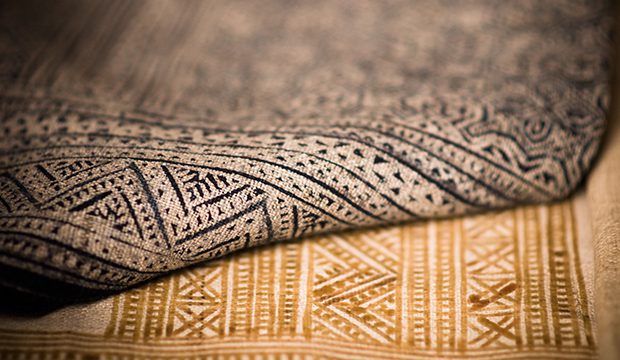

The past few years have seen a renewed appreciation for handcraft in the world of fashion. This is especially true when it comes to textiles- particularly for more decorative fabrics. Hand weaving, dyeing, and printing have all been trending. And why not? This kind of careful, labor-intensive work yields gorgeous results.
Prints are a popular way to bring this special touch into a collection. In fact, there is one printing technique that has been spotted on a number of runways in the past few seasons- woodblock printing. Whether it is handcrafted in-house, a recycled vintage piece, or re-interpreted in digital form, block printing has inspired a number of looks.
If you are unfamiliar with wood block printing, the process is relatively straightforward. It is an art form that has been used to print all kinds of things, from books to fine art. But the most interesting application (to us fashion designers anyway), is block printing on textiles.
Here’s how it works: an image is carved into a block of wood (the negative space is removed), to create a stamp. The block is then coated with dye and used to stamp a pattern right onto the fabric. It creates a beautifully “imperfect” handmade look that has become classic in prints.
But of course, this art form has been around since long before runways and trends came to be. While it is difficult to ascertain exactly when block printing was developed, it’s roots can be traced back to the ancient days of several nations, such as China, Egypt, Assyria, and of course, India. Handcrafted fabrics were a significant part of each of these cultures, and all used a variety of techniques to create beautiful, intricate surface design. Painting, stitching, dyeing, printing, and other art forms were all used- often interchangeably. Block printing was just another way to create an ornamental surface.
While we think of clean white linen when we think of ancient Egypt, block printing was still rather widespread at the time. For example, the tombs of Beri Hassan (who lived in 2100 B.C.) featured walls decked out in multicolored patterned fabrics. Even the ancient Greeks loved pattern- evidence of block printed fabrics were found that dated as far back as the fourth or fifth century B.C.
In China, woodblock printing was developed during the Tang dynasty, with the first examples appearing around the year 600. This innovation was likely inspired by two much older techniques: using bronze or stone seals to make impressions on malleable materials such as clay or silk, and taking rubbings from reliefs made of bronze or stone.
Of course, the place in which block printing is most deeply embedded in the culture is India. Often, when we think of block printed fabric, we immediately think of this eastern country, as it is so synonymous with this technique. In fact, wood block printing there is such an art form that even the stamps themselves look like beautiful, intricately carved sculptures. Indian block printing has become a classic fabric style that seems to be timeless (especially considering how trendy it is today.) Block printing traditions stretch as far back as the 12th century, with many areas cultivating their own styles that are renowned throughout the world.
The main areas of India known for their stunning block prints are Gujarat and Rajasthan. In Gujarat, the technique was developed and practiced by Paithapur families, who created very intricate textiles using printing in conjunction with mud resist. This style is referred to as a Sodag iri print. Various regions of Gujarat have their own print styles as well, with motiffs such as birds or fruit. Natural dyes are the traditional printing inks, such as indigo and madder root to create the beautiful colors that are characteristic of India.
Block printing eventually spread from Gujarat to Rajasthan, where many colorful and classic print styles were developed, such as calico. This familiar design is traditionally created by printing the outlines first, and filling the color in afterwards. The region would eventually become a trading hub that would help bring block printing to the western world (this could be the reason that many traditional motifs from the area are so well-recognized).
By the 15th century, Portugese traders discovered the beautiful fabrics being crafted in India- these textiles quickly became high demand in Europe, and trade between the East and the West gained momentum. The 17th century saw the East India Company granted with a monopoly on trade, and thus, Indian block printed fabrics. Small quantities were shipped, making them that much more precious. India reached its peak as a textile exporter during the 18th and 19th centuries. However, the market was undermined when England developed machinery and synthetic dyes that could effectively “fake” the block printed look.
Despite being largely overtaken by newer technology, wood block printing still remains relevant in fashion and textiles. Whether a designer is using the technique as inspiration for a digital print or carving a stamp herself, the look is beautiful and timeless.
